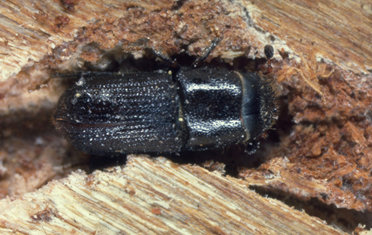Destructive beetle found in the Pine Bush
A beetle that poses a threat to pine forests was caught in a trap near Rapp Road, according to a press release from the state’s Department of Environmental Conservation; this is the farthest north the southern pine beetle has been confirmed.
The public is being asked to report any recently dead or dying pitch pine or red pine trees.
The bark beetle, native to the southern United States, has steadily expanded its range north and west, most likely in response to climate change, the DEC says. Considered one of the most destructive forest pests in the United States, the southern pine beetle attacks several species of pine including pitch pine, an iconic species of the Pine Bush and other pine barrens throughout the state. Trees can die quickly from repeated beetle attacks, often succumbing within two to four months.
DEC’s Division of Lands and Forests and the Albany Pine Bush Preserve Commission began placing early detection traps in the preserve in 2015. Additional traps set in the Hudson Valley by the DEC and its partners have confirmed the presence of southern pine beetle in Minnewaska State Park, Bear Mountain State Park, Schunnemunk State Park, and Roosa Gap State Forest in 2016 and 2017.
Despite these detections, infested trees have not yet been found north of Long Island. The beetles are likely persisting at low levels upstate and therefore not causing the widespread tree mortality like that observed on Long Island. The Albany Pine Bush Preserve will be added to the locations identified for continued aerial and ground monitoring to search for infested trees.
The commission does extensive forest thinning and prescribed burning to restore the globally-rare inland pine barrens and, in the process, has created young forest habitat, increased populations of the endangered Karner blue butterfly, and improved ecosystem health. The healthier pines are better equipped to withstand attack by the beetles, the DEC says. A more open forest structure also disrupts the beetle’s chemical communication, preventing them from attacking in large groups and overwhelming a tree’s defenses.
Last year, $3 million from the Environmental Protection Fund was targeted to help manage the spread of the southern pine beetles, bolstering the DEC’s ongoing efforts to manage the invasive species, which has killed thousands of pine trees on Long Island since it was first discovered in 2014. The governor’s 2018-19 budget proposes an additional $250,000 for prescribed burns, which would help increase forest health and resistance to the southern pine beetle on Long Island.
The DEC is asking the public to report any recently dead or dying pitch pine or red pine trees they see outside of Long Island, especially if there are several trees grouped together and they are dying quickly. Sightings may be reported to the Forest Health Diagnostic Lab through the toll-free information line, 1-866-640-0652, or by email to . People reporting dying pine trees by email are asked to send photos of the trees and close-ups of any damage and to include something in the photos for scale, such as a penny, to help with identification.

